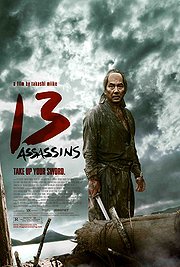Reviews Too Late: 13 Assassins
by wjw on October 2, 2011

13 Assassins is a terrific film, but only if you’re the sort of person who enjoys films that end with an excruciating 40-minute bloodbath in which a couple hundred people are sliced, decapitated, shot, disemboweled, stabbed, run through, blown up, buried under collapsing buildings, and trampled by a herd of stampeding cattle that have been set on fire!
There’s a certain awesome genius in that last, isn’t there?
13 Assassins is a remake of a 1963 film which I haven’t seen, the remake directed by Takashi Miike, some of whose 60-odd films have gained cult status in the West for their unflinching depiction of violence and psychosis (Ichi the Killer).
The film is set in 1844, in the very last generation of the Shogunate. The Shogun’s half-brother, Naritsugu, is a decadent aesthete who, because he’s bored by the meaninglessness of life at court, has become a sadistic, murderous, raping monster. Putting him on trial would embarrass those in power, so the Shogun leaves it to one of his ministers, Sir Doi, to deal with the matter quietly.
This is only for certain values of “quietly,” mind.
Rather than employ the ninja who have been serving the Shogunate for centuries, Sir Doi inexplicably recruits swordsman Shinzaemon to raise a team of assassins from among the samurai, which makes it a samurai film instead of a ninja film. (The Japanese would probably classify the movie as a chanbara, meaning swordfight film.)
Since there’s been peace for hundreds of years and the life of the samurai has become one of empty ritual, Shinzaemon has a hard time finding enough swordsmen who know a tsuba from their elbow and can be counted upon in combat. In the end he can find only twelve, and along the way these twelve adopt a kind of Wild Man of the Woods, an expert at firing big rocks from his sling, which brings their numbers to thirteen.
The psychotic bad guy in turn recruits Hanbei, an old sparring partner of Shinzaemon. Hanbei realizes he’s in the employ of a sociopath, but (1) he’s traditional enough a samurai to want to serve his lord faithfully regardless, and (2) he’s also tainted by ambition, and wants to rise at court, and figures Prince Naritsugu is his ticket to high office.
Prince Naritsugu is obliged to visit his clan on an annual visit, so our heroes plan to ambush him along the way. They buy an entire village and turn it into a death trap. Hanbei senses something is up and sends for extra guards, so it’s 200 samurai who show up for the finale, to be shot, stabbed, blown up, and trampled by the flaming cattle.
There’s a telling moment in the finale. Naritsugu and his escort have been trapped in the village. Many have been killed. Our heroes are standing on the rooftops raining arrows down on them and pretty much killing them at will.
And then Shinzaemon and his crew decide that, even though they have plenty of arrows left, this just isn’t samurai enough for them, and they draw their swords, drop down into the streets, and commence deeply cinematic, gruesome slicing and dicing. Of course they’re still outnumbered about ten to one, and most of them die before Shinzaemon, Hanbei, and Prince Naritsugu can meet in the blood-soaked streets for their personal showdown.
There’s serious irony here, because in just a few years Commodore Perry and his Black Ships are going to steam into Tokyo Bay, and the samurai, the Shogunate, and their culture will be swept away. It really doesn’t matter who gets to be the next Shogun, he’s doomed anyway. Even without knowing this, Shinzaemon and everyone else sense that this is the samurais’ last hurrah. Maybe they throw away their bows and charge in with swords because, in their hearts, they know it really doesn’t matter.
All through the film I kept comparing it to Kurosawa’s Seven Samurai, which has a similar setup: a small group of warriors defend a village against overwhelming numbers. Both films have scenes where the leaders choose the members of their posse, both groups have an eccentric half-comic mascot who isn’t a real samurai but who fights bravely anyway, both have a showdown in the mud and the rain. The comparisons are pretty much inevitable.
Seven Samurai is the superior film— but then we knew that going in, right? Kurosawa develops the characters of the samurai, he shows us the life of the peasants and makes us care for them; and the female characters, though few, are all well drawn. Takashi’s movie has a couple fewer hours of running time, and he’s got more heroes to develop as well as some of the villains, so a number of our thirteen heroes are given short shrift, and we don’t really care about them. The common people aren’t really in the picture, and the few women are victims who die horribly at the villain’s hands.
With Takashi, it’s all about the blood, the slaughter, the High Crazy, and the flaming cattle. And if that’s the sort of thing you like, 13 Assassins is definitely the sort of thing you’ll like.